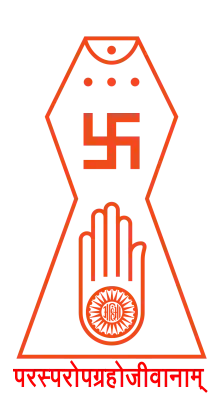Vasantgarh hoard
In 1956,[1] 240 Jain bronze idols were discovered dating back to early medieval to medieval period.The Vasantgarh hoard, thus named after the place of discovery, Vasantgarh is located in the Sirohi District of Rajasthan, India.
| Vasantgarh hoard | |
|---|---|
| Year | 6th century - 11th century |
| Medium | Bronze |
| Part of a series on |
| Jainism |
|---|
 |
|
|
Description
In 1956,[1] 240 bronze idols were discovered dating back to early medieval to medieval period.[2] The vast number of idols found Vasantgarh is the evidence of strong foothold Jainism had a in the area.[3] Vasantgarh hoard along with Akota bronzes and devni-mori (Idar) are important bronze hoards found in Gujarat and Kathiawar province.[4] The akota and vasantgarh were predominately influenced by Gupta and Gandhara style. It is indicated by the idols that it is influenced by more styles like styles during reign of Harsha and maitraka of Valabhi.[5] Idols of this hoards shows images of tirthankar, sashandevatas(yaksha and yakshi) and Jain deities in Shwetambar iconography.[6][7] The images found in this hoard is small in size and were cast by the cire-perdue (lost-wax casting) process, and the eyes and ornaments are frequently inlaid with silver and gold.[8]
Major images
The idol of Goddess Sarasvati along with an ornate crown standing on a lotus pedestal with a lotus stem in one hand and manuscript in other. This idol found in the hoard resembling the iconography of Sarasvati found akota bronzes. The idol has now been placed inside Mahavir temple of Pindwara and worshipped as Chakreshvari.[9] Two beautiful idol of Rishabhanatha dating back to 6th and 7th century AD.[10] A sat-tirthika, dates to 998 AD, bronze image of parshvanatha with sarvanha and ambika devi.[11] The chaturvimsatipatta of adinatha and tritirthi Parshvanatha built-in Vasantgarh style dating back to 1066 and 1078 respectively are noteworthy.[12]
See also
References
Citation
- Shah 1995, p. 4.
- Shah 1995, p. 68.
- Mishra & Ray 2016, p. 159.
- Goetz 1955, p. 38.
- Collins 1988, p. 97.
- Owen 2012, p. 82.
- Pereira 1977, p. 6.
- Britannica & Western Indian bronze.
- Ludvik 2007, pp. 242-244.
- Shah 1987, p. 115.
- Shah 1987, p. 249.
- Mishra & Ray 2016, p. 148.
Source
- Mishra, Susan Verma; Ray, Himanshu Prabha (2016), The Archaeology of Sacred Spaces: The temple in western India, 2nd century BCE–8th century CE, Routledge, ISBN 9781317193746
- Goetz, Hermann (1955), The Early Wooden Temples of Chamba, Brill Archive
- Ludvik, Catherine (2007), Sarasvatī: Riverine Goddess of Knowledge: From the Manuscript-carrying Vīṇā-player to the Weapon-wielding Defender of the Dharma, BRILL, ISBN 9789047420361
- Pereira, José (1977), Monolithic Jinas: The Iconography of the Jain Temples of Ellora, Motilal Banarsidass, ISBN 9780842610278
- Shah, Umakant Premanand (1995), Studies in Jaina Art and Iconography and Allied Subjects in Honour of Dr. U.P. Shah, Abhinav Publications, ISBN 9788170173168
- "Western Indian bronze". Encyclopædia Britannica.
- Shah, Umakant Premanand (1987), Jaina-rūpa-maṇḍana: Jaina iconography, Abhinav Publications, ISBN 9788170172086
- Collins, Charles Dillard (1988), The Iconography and Ritual of Siva at Elephanta: On Life, Illumination, and Being, SUNY Press, ISBN 9780887067730
- Owen, Lisa (2012), Carving Devotion in the Jain Caves at Ellora, BRILL, ISBN 9789004206304
